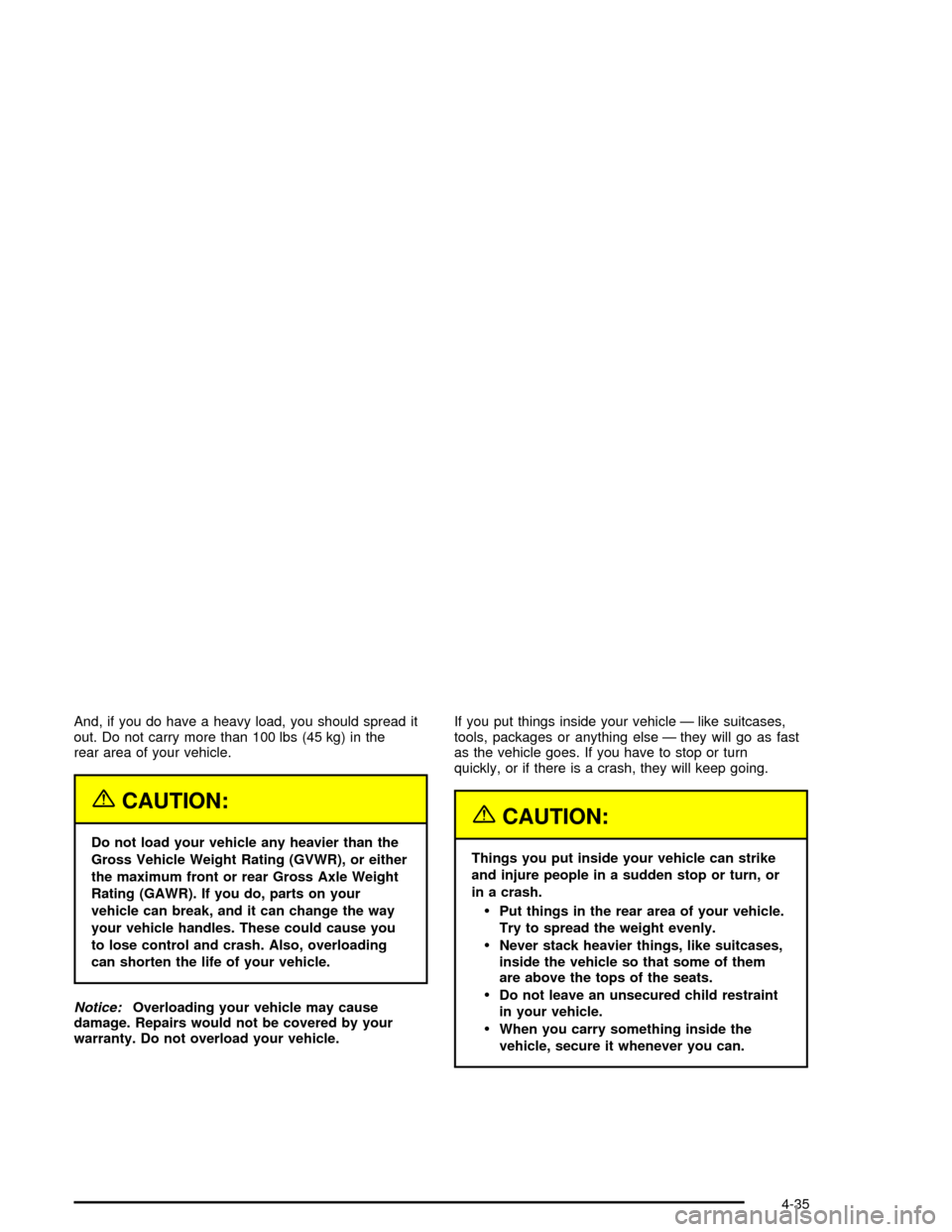2005 CHEVROLET CORVETTE seats
[x] Cancel search: seatsPage 263 of 400

And, if you do have a heavy load, you should spread it
out. Do not carry more than 100 lbs (45 kg) in the
rear area of your vehicle.
{CAUTION:
Do not load your vehicle any heavier than the
Gross Vehicle Weight Rating (GVWR), or either
the maximum front or rear Gross Axle Weight
Rating (GAWR). If you do, parts on your
vehicle can break, and it can change the way
your vehicle handles. These could cause you
to lose control and crash. Also, overloading
can shorten the life of your vehicle.
Notice:Overloading your vehicle may cause
damage. Repairs would not be covered by your
warranty. Do not overload your vehicle.If you put things inside your vehicle — like suitcases,
tools, packages or anything else — they will go as fast
as the vehicle goes. If you have to stop or turn
quickly, or if there is a crash, they will keep going.
{CAUTION:
Things you put inside your vehicle can strike
and injure people in a sudden stop or turn, or
in a crash.
Put things in the rear area of your vehicle.
Try to spread the weight evenly.
Never stack heavier things, like suitcases,
inside the vehicle so that some of them
are above the tops of the seats.
Do not leave an unsecured child restraint
in your vehicle.
When you carry something inside the
vehicle, secure it whenever you can.
4-35
Page 318 of 400

(D) Construction Code:A letter code is used to
indicate the type of ply construction in the tire. The letter
R means radial ply construction; the letter D means
diagonal or bias ply construction; and the letter B means
belted-bias ply construction.
(E) Rim Diameter:Diameter of the wheel in inches.
(F) Service Description:These characters represent
the load range and speed rating of the tire. The load
index represents the load carry capacity a tire is certi�ed
to carry. The load index can range from 1 to 279. The
speed rating is the maximum speed a tire is certi�ed
to carry a load. Speed ratings range from A to Z.
Tire Terminology and De�nitions
Air Pressure:The amount of air inside the tire pressing
outward on each square inch of the tire. Air pressure
is expressed in pounds per square inch (psi) or
kilopascal (kPa).
Accessory Weight:This means the combined weight
of optional accessories. Some examples of optional
accessories are, automatic transmission, power steering,
power brakes, power windows, power seats, and air
conditioning.
Aspect Ratio:The relationship of a tire’s height to
its width.Belt:A rubber coated layer of cords that is located
between the plies and the tread. Cords may be made
from steel or other reinforcing materials.
Bead:The tire bead contains steel wires wrapped by
steel cords that hold the tire onto the rim.
Bias Ply Tire:A pneumatic tire in which the plies are
laid at alternate angles less than 90 degrees to the
centerline of the tread.
Cold In�ation Pressure:The amount of air pressure in
a tire, measured in pounds per square inch (psi) or
kilopascals (kPa) before a tire has built up heat
from driving. SeeIn�ation - Tire Pressure on page 5-58.
Curb Weight:This means the weight of a motor
vehicle with standard and optional equipment including
the maximum capacity of fuel, oil and coolant, but
without passengers and cargo.
DOT Markings:A code molded into the sidewall of a
tire signifying that the tire is in compliance with the U.S.
Department of Transportation (DOT) motor vehicle
safety standards. The DOT code includes the Tire
Identi�cation Number (TIN), an alphanumeric designator
which can also identify the tire manufacturer, production
plant, brand and date of production.
GVWR:Gross Vehicle Weight Rating, seeLoading
Your Vehicle on page 4-31.
5-54
Page 349 of 400

Electrical System
Add-On Electrical Equipment
Notice:Don’t add anything electrical to your
vehicle unless you check with your dealer �rst.
Some electrical equipment can damage your
vehicle and the damage wouldn’t be covered by
your warranty. Some add-on electrical equipment
can keep other components from working as
they should.
Your vehicle has an air bag system. Before attempting
to add anything electrical to your vehicle, see
Servicing Your Airbag-Equipped Vehicle on page 1-51.
Headlamp Wiring
The headlamp wiring is protected by fuses. An electrical
overload will cause the lamps to remain off. If this
happens, have your headlamp wiring checked right away.
Windshield Wiper Fuses
The windshield wiper motor is protected by a fuse and
an internal circuit breaker. If the motor overheats
due to heavy snow, etc., the wiper will stop until the
motor cools. If the overload is caused by some electrical
problem and not snow, etc., be sure to get it �xed.
Power Windows and Other Power
Options
Circuit breakers protect the power seats, power
windows, and other power accessories. When the
current load is too heavy, the circuit breaker opens and
closes, protecting the circuit until the problem is �xed
or goes away.
Fuses and Circuit Breakers
The wiring circuits in your vehicle are protected from
short circuits by a combination of J-Case fuses,
mini-fuses and circuit breakers. This greatly reduces the
chance of �res caused by electrical problems.
Look at the silver-colored band inside the fuse. If the
band is broken or melted, replace the fuse. Be sure you
replace a bad fuse with a new one of the identical
size and rating.
If you ever have a problem on the road and do not have
a spare fuse, you can borrow one that has the same
amperage. Just pick some feature of your vehicle
that you can get along without – like the radio or
cigarette lighter – and use its fuse, if it is the correct
amperage. Replace it as soon as you can.
5-85
Page 352 of 400

Fuses Usage
TONNEAU
RELSETonneau Release
TRUNK RELSE Trunk Release
REAR/ FOG Rear Fog Lamps
FUEL DR
RELSEFuel Door Release
BLANK Not Used
BLANK Not Used
Fuses Usage
CIG LTR Cigarette Lighter
DRVR
HTD SEATDriver’s Heated Seat
WPR DWELL Wiper Dwell
BLANK Not Used
AUX PWR Auxiliary Power
Fuses Usage
PASS
HTD SEATPassenger’s Heated Seat
BLANK Not Used
PWR WNDWS/
FUEL RELSEPower Windows, Fuel Door Release
TRUNK RELSE Trunk Release
PWR LUMBAR Power Lumbar
BLANK Not Used
PWR SEATS
MEMORY
SEATSPower Seats, Memory Seats
BLANK Not Used
BLANK Not Used
WPR/WASHER Windshield Wiper/Washer
BLANK Not Used
5-88
Page 392 of 400

Fuel (cont.)
Fuels in Foreign Countries.............................. 5-6
Gage.........................................................3-48
Gasoline Octane........................................... 5-5
Gasoline Speci�cations.................................. 5-5
Fuses
Engine Compartment Fuse Block...................5-89
Fuses and Circuit Breakers...........................5-85
Instrument Panel Fuse Block.........................5-86
Windshield Wiper.........................................5-85
G
Gage
Engine Coolant Temperature.........................3-41
Engine Oil Pressure.....................................3-46
Fuel..........................................................3-48
Speedometer..............................................3-34
Tachometer.................................................3-34
Voltmeter Gage...........................................3-37
Garage Door Opener.......................................2-42
Gasoline
Octane........................................................ 5-5
Speci�cations............................................... 5-5
Glove Box.....................................................2-46
GM Mobility Reimbursement Program.................. 7-5
H
Hatch/Trunk...................................................2-14
Hazard Warning Flashers................................... 3-6
Headlamp Wiring............................................5-85
Headlamps
Bulb Replacement.......................................5-44
Daytime Running Lamps...............................3-16
Flash-to-Pass............................................... 3-9
Halogen Bulbs............................................5-45
Headlamps, Front Turn Signal, and
Parking Lamps.........................................5-45
High Intensity Discharge (HID) Lighting...........5-44
High/Low Beam Changer................................ 3-9
On Reminder..............................................3-16
Sidemarker Lamps.......................................5-47
Wiper Activated...........................................3-16
Head-Up Display (HUD)...................................3-20
Heated Seats................................................... 1-4
Heater...........................................................3-25
Highbeam On Light.........................................3-47
Highway Hypnosis...........................................4-24
Hill and Mountain Roads..................................4-24
HomeLink
®Wireless Control System.................2-42
HomeLink®Wireless Control System Operation.....2-43
6
Page 394 of 400

Light (cont.)
Anti-Lock Brake System Warning...................3-39
Brake System Warning.................................3-38
Fog Lamp..................................................3-47
Highbeam On.............................................3-47
Lights On Reminder.....................................3-47
Malfunction Indicator....................................3-42
One-to-Four Shift.........................................3-38
Safety Belt Reminder...................................3-34
Security.....................................................3-47
TCS Warning Light......................................3-40
Tire Pressure..............................................3-42
Traction Control System (TCS) Warning..........3-40
Lighting
Entry/Exit...................................................3-19
Limited-Slip Rear Axle.....................................4-11
Loading Your Vehicle.......................................4-31
Lockout Protection..........................................2-13
Locks
Automatic Door Locks..................................2-13
Door..........................................................2-10
Lockout Protection.......................................2-13
Power Door................................................2-12
Programmable Automatic Door Unlock............2-13
Loss of Control...............................................4-16
Lumbar
Power and Side Bolsters................................ 1-3M
Maintenance Schedule
Additional Required Services........................... 6-6
At Each Fuel Fill........................................... 6-9
At Least Once a Month.................................. 6-9
At Least Once a Year.................................... 6-9
Introduction.................................................. 6-2
Maintenance Footnotes.................................. 6-7
Maintenance Record....................................6-16
Maintenance Requirements............................. 6-2
Normal Maintenance Replacement Parts.........6-14
Owner Checks and Services........................... 6-8
Recommended Fluids and Lubricants.............6-12
Scheduled Maintenance................................. 6-4
Using.......................................................... 6-2
Your Vehicle and the Environment................... 6-2
Malfunction Indicator Light................................3-42
Manual Seats................................................... 1-2
Manual Transmission
Fluid..........................................................5-20
Operation...................................................2-27
Memory.........................................................2-68
Message
DIC Warnings and Messages........................3-54
8
Page 396 of 400

Power
Accessory Outlets........................................3-24
Door Locks.................................................2-12
Electrical System.........................................5-85
Lumbar and Side Bolsters.............................. 1-3
Retained Accessory (RAP)............................2-22
Six-Way Seats.............................................. 1-2
Steering Fluid.............................................5-31
Windows....................................................2-17
Pretensioners, Safety Belt................................1-20
Programmable Automatic Door Unlock...............2-13
Q
Questions and Answers About Safety Belts.........1-11
R
Radios..........................................................3-78
Care of Your CD Player...............................3-99
Care of Your CDs........................................3-99
Navigation/Radio System, see Navigation
Manual...................................................3-98
Radio with CD............................................3-79
Setting the Time..........................................3-78
Theft-Deterrent............................................3-98
Understanding Reception..............................3-98Reading Lamps..............................................3-19
Rear Axle......................................................5-43
Limited-Slip.................................................4-11
Rear Storage Area..........................................2-48
Rearview Mirror, Automatic Dimming with
Compass....................................................2-37
Rearview Mirror, Automatic Dimming with
OnStar
®and Compass.................................2-35
Rearview Mirrors.............................................2-35
Reclining Seatbacks.......................................... 1-4
Recommended Fluids and Lubricants.................6-12
Recreational Vehicle Towing.............................4-36
Removing the Roof Panel................................2-52
Replacement Bulbs.........................................5-48
Replacement, Windshield.................................5-48
Reporting Safety Defects
Canadian Government..................................7-10
General Motors...........................................7-11
United States Government............................7-10
Restraint System Check
Checking the Restraint Systems....................1-51
Replacing Restraint System Parts
After a Crash..........................................1-52
Retained Accessory Power (RAP)......................2-22
Roadside
Assistance Program....................................... 7-5
Rocking Your Vehicle to Get it Out....................4-31
10
Page 397 of 400

Roof Panel....................................................2-52
Installing the Roof Panel...............................2-55
Removing the Roof Panel.............................2-52
Storing the Roof Panel.................................2-54
Routing, Engine Drive Belt...............................6-15
Running the Engine While Parked.....................2-34
S
Safety Belt
Pretensioners..............................................1-20
Reminder Light............................................3-34
Safety Belts
Care of......................................................5-78
Driver Position............................................1-13
How to Wear Safety Belts Properly................1-12
Passenger Position......................................1-20
Questions and Answers About Safety Belts.....1-11
Safety Belt Extender....................................1-20
Safety Belt Use During Pregnancy.................1-19
Safety Belts Are for Everyone......................... 1-7
Safety Warnings and Symbols.............................. iii
Scheduled Maintenance..................................... 6-4
Seatback Latches............................................. 1-6Seats
Heated Seats............................................... 1-4
Manual........................................................ 1-2
Power Lumbar and Side Bolsters.................... 1-3
Reclining Seatbacks...................................... 1-4
Seatback Latches.......................................... 1-6
Six-Way Power Seats.................................... 1-2
Securing a Child Restraint
Designed for the LATCH System...................1-33
Passenger Seat Position...............................1-35
Security Light.................................................3-47
Selective Ride Control.....................................4-12
Service........................................................... 5-3
Adding Equipment to the Outside of Your
Vehicle..................................................... 5-5
Doing Your Own Work................................... 5-4
Engine Soon Light.......................................3-42
Publications Ordering Information...................7-11
Servicing Your Airbag-Equipped Vehicle..............1-51
Setting the Time.............................................3-78
Shifting Into Park (P).......................................2-30
Shifting Out of Park (P)...................................2-32
Signals, Turn and Lane-Change.......................... 3-8
Speci�cations, Capacities.................................5-92
Speedometer..................................................3-34
11